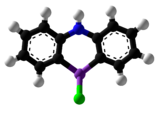Adamsite
This article needs additional citations for verification. (September 2007) |

| |||
| |||
| Names | |||
|---|---|---|---|
| Preferred IUPAC name
10-Chloro-5,10-dihydrophenazarsinine | |||
| Other names
10-Chloro-5H-phenarsazinine
Diphenylaminechlorarsine | |||
| Identifiers | |||
| |||
3D model (JSmol)
|
| ||
| Abbreviations | DM | ||
| ChemSpider |
| ||
| ECHA InfoCard | 100.008.577 | ||
| EC Number |
| ||
| MeSH | Phenarsazine+chloride | ||
PubChem CID
|
| ||
| UNII |
| ||
CompTox Dashboard (EPA)
|
| ||
| |||
| |||
| Properties | |||
| C12H9AsClN | |||
| Molar mass | 277.58 g·mol−1 | ||
| Appearance | Yellow-green crystals | ||
| Melting point | 195 °C (383 °F; 468 K) | ||
| Boiling point | 410 °C (770 °F; 683 K) | ||
| 0.064 g dm−3 | |||
Except where otherwise noted, data are given for materials in their standard state (at 25 °C [77 °F], 100 kPa).
| |||
Adamsite or DM is an organic compound; technically, an arsenical diphenylaminechlorarsine, that can be used as a riot control agent. DM belongs to the group of chemical warfare agents known as vomiting agents or sneeze gases.[1] First synthesized in Germany by Heinrich Otto Wieland in 1915, it was independently developed by the US chemist Roger Adams (for whom it is named) at the University of Illinois in 1918.
Composition
DM is an odourless crystalline compound with a very low vapour pressure. The colour of the crystals ranges from bright yellow to dark green depending on the purity. It is readily soluble in some organic solvents (e.g., acetone, dichloromethane), but nearly insoluble in water. In vaporous form it appears as a canary yellow smoke.[2]
Effects
Adamsite is usually dispersed as an aerosol, making the upper respiratory tract the primary site of action. Although the effects are similar to those caused by typical riot control agents (e.g. CS), they are slower in onset but longer in duration, often lasting for 12 or more hours.[1] After a latency period of 5–10 minutes irritation of the eyes, lungs and mucous membranes develops followed by headache, nausea and persistent vomiting.[1]
Usage
DM was produced and stockpiled by the British and the United States at the end of World War I. It was used by the British during the incursions at Murmansk and Arkhangelsk.[3] It is now regarded as obsolete and has been widely replaced by riot control agents such as CS which are less toxic and more rapid in the onset of symptoms. Early battlefield use was intended to be via "adamsite candles". These were large metal cans or tubes (weighing approximately 5 pounds (2.3 kg)) which contained a smoke composition made of adamsite plus a slow burning pyrotechnic composition. A series of candles were lit and the adamsite-laden smoke allowed to drift towards the enemy.[4]
In the United States, it was used against the Bonus Army who demonstrated in Washington, DC, in 1932, reportedly causing the death and serious injury of several children who had accompanied their parents on the protests. It was again used in the Vietnam War.[5]
In 2003, North Korea was reportedly producing adamsite at its Aoji-ri Chemical Complex in Haksong-ri, Kyŏnghŭng county for stockpiling.[6] DM was allegedly used by Venezuelan authorities in the 2014–17 Venezuelan protests and described as "green gas"[7][8] with reports of protesters vomiting following exposure[9][10][11] and regional human rights groups condemning the usage of "green gas", stating that its usage is "internationally banned".[12]
References
- ^ a b c Committee on Review and Evaluation of the Army Non-Stockpile Chemical Materiel Disposal Program, U.S. National Research Council. Disposal of Chemical Agent Identification Sets, (Google Books), p. 15, National Academies Press, 1999, (ISBN 0-309-06879-7).
- ^ Adamsite (DM) Vomiting Agent. National Institute for Occupational Safety and Health. August 22, 2008. Retrieved December 22, 2008.
- ^ When Chemical Weapons Were First Dropped From the Air, North Russia 1919 Simon Jones. Imperial War Museum Review. No. 12, 1999. Retrieved September 3, 2015.
- ^ Albright, Richard (2011-12-02). Cleanup of Chemical and Explosive Munitions: Location, Identification and Environmental Remediation. William Andrew. ISBN 9781437734782.
- ^ Bunn, George (1969). "Banning Poison Gas and Germ Warfare: Should the United States Agree" (PDF). Wisconsin Law Review. 1969 (2): 405. Archived from the original (PDF) on 2014-07-02. Retrieved 2013-08-05.
- ^ Chemical Agents: Adamsite Archived July 29, 2005, at the Wayback Machine. Nuclear Threat Initiative (NTI). March 2003.
- ^ Gómez De Anda, Lizeth (17 February 2014). "TV Chavista inventa apoyo a Maduro :: La Razón :: 9 de abril de 2017". La Razón. Archived from the original on 10 April 2017. Retrieved 9 April 2017.
- ^ "15F Gas Verde usado por la Guardia Nacional: su efecto". Venezuela Awareness Foundation. 15 February 2014. Retrieved 9 April 2017.
- ^ "Ricardo Hausmann Professor of the Practice of Economic Development Director of Center for International Development Center for International Development". Harvard Kennedy School. Archived from the original on 19 February 2014. Retrieved 18 February 2014.
- ^ Hausmann, Ricardo. "Professor Ricardo Hausmann Director of the Center for International Development at Harvard University". Retrieved 18 February 2014.
- ^ Hausmann, Ricardo. "Venezuelan govt repressing demonstrations with new green gas that makes people vomit. How much longer until they use nerve gas?". Retrieved 18 February 2014.
- ^ Prato, Marla (2 May 2015). "Dos heridos y allanamientos realiza la Guardia Nacional en Lara". El Universal (in Spanish). Retrieved 9 April 2017.
External links
- Adamsite in the NIOSH emergency response database
- Case definition of adamsite poisoning (from the U.S. CDC)

